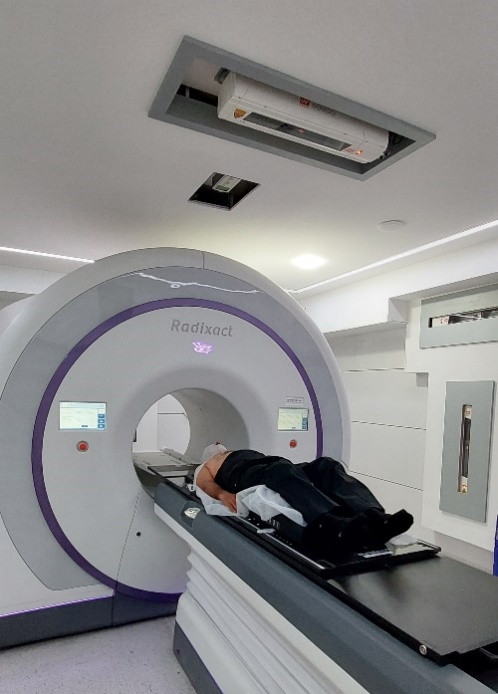Go to AFOMP Pulse Contents/Index Page
Mohammad Amin Mosleh-Shirazi PhD CSci
President, Iranian Association of Medical Physicists
Head of Radiotherapy Physics Unit, Department of Radio-oncology, Namazi Teaching Hospital, Shiraz University of Medical Sciences, Shiraz, Iran
(On behalf of the Executive Committee Members of the IAMP)
Being one of the main modalities for treatment of cancer, the status and quality of the radiation therapy (RT) service available in a country can be deemed as an important factor for the overall success of the battle against cancer in that country. In what follows, a brief history of the development of RT in Iran leading to the current status will be presented, emphasizing on the RT facilities and their use of equipment.
External-beam RT started in Iran in the 1950s. Through the first few decades, the equipment that were employed included cesium-137 and cobalt-60 machines as well as kilovoltage x-ray units. Then, a relatively small number of linear accelerators were gradually introduced at some centers. That included seven ZDAJ Neptun® machines in the mid-to-late 1990s. By the end of the first decade of the new millennium, due to a number of reasons, there were still a larger number of cobalt-60 units in use than linear accelerators.
Through efforts by the concerned professional bodies (including the IAMP) as well as various leading individuals, the start of a major ‘sea change’ happened around 2010 by means of purchasing 30 Elekta Compact® linear accelerators by the Iranian Ministry of Health, in one the largest single purchases in the history of RT worldwide in terms of the number of accelerators. These relatively simple, single-energy and single-modality machines replaced the cobalt-60 units or older linacs in existing centers, as well as being installed as the first machine at a number of newly established RT clinics.
Following this injection of resources, establishment of new RT centers has been increasing at pace, predominantly in the private sector. In 2010, the number of external-beam RT facilities in the country was around 35, which has more than doubled now. In this period, there has been an approximately six-fold increase in the number of existing or planned external-beam RT machines, which now exceeds 200. This means an increase in the number of machines per million population from about 0.5 to approximately 2.5. Importantly, the type and technological capabilities of the machines have also improved substantially. Most of the machines are equipped with (at least) multileaf collimators and electronic portal imaging devices. In addition to various brands of advanced C-arm linacs capable of delivering IMRT/VMAT/SRS/SBRT with IGRT, about 30 of the installed/planned machines are dedicated RT units (Radixact® tomotherapy with or without Synchrony®, Cyberknife® and GammaKnife®). Figure 1 shows the picture of one of the helical tomotherapy units in clinical use. Plans for a national ion therapy center are underway too.

Figure 1. An Accuray Radixact X9 helical tomotherapy unit pictured after a daily MVCT scan for online setup verification of a head-and-neck cancer patient, prior to the delivery of the treatment. A synchrony motion synchronization system will also be installed shortly on this unit. (Radio-oncology Department, Namazi Teaching Hospital, Shiraz, Iran)
As for brachytherapy units using afterloaders, a selected number of centers have been equipped through the years with increasingly advanced machines, from multi-cobalt-60-source Cathetron®, to multi-cesium-137-source Selectron®, single-source Iridium-based HDR and most recently, modern single-source cobalt-60-based HDR afterloaders. There are around 25 existing/planned brachytherapy afterloading machines in the country. CT/MRI/ultrasound guidance, radioactive seed implants, surface molds and/or ophthalmic applications are offered in specialist referral centers. There are also a few intraoperative RT units in clinical use.
Towards safeguarding the accuracy of the planned and delivered treatments along with the introduction of new technologies, a national independent dosimetric audit program has been carried out by the IAMP for the past 10 years. RT centers installing any new combinations of linear accelerator, treatment planning system or CT simulator are mandated by the national regulatory body to undergo the IAMP audit. This external dosimetric audit follows the methodology recommended by the IAEA-TECDOC-1583 and is applicable to 3D conformal external-beam RT. Plans for extending the audit to brachytherapy and IMRT/VMAT/tomotherapy are also underway.
To sum up, utilization of modern RT equipment in the country has happened at a relatively slow rate until fairly recently. The recent 10 years or so, however, have seen a sharp transformation in the number of RT centers as well as the number and quality of the equipment and emergence of advanced techniques. Of course, there is still a need for more widespread but safe use of state-of-the-art technologies and techniques, with better geographical distribution throughout the country.
In addition to substantial improvements in patient treatments, these advances have been reflected in the type of research carried out at the RT centers affiliated with universities and research centers, too. Similarly, the scientific contents of seminars, conferences and workshops in this country have been directed increasingly towards new technologies. For example, the main theme of the upcoming Iranian Conference of Medical Physics in August 2024 will be the artificial intelligence technologies.